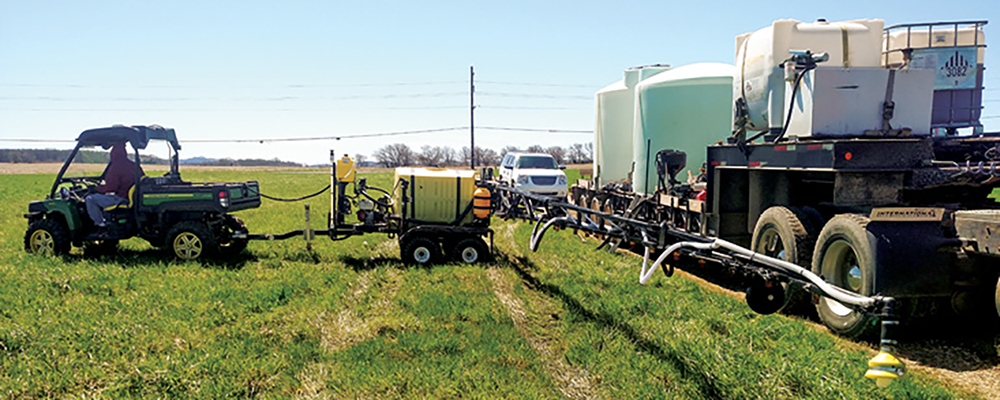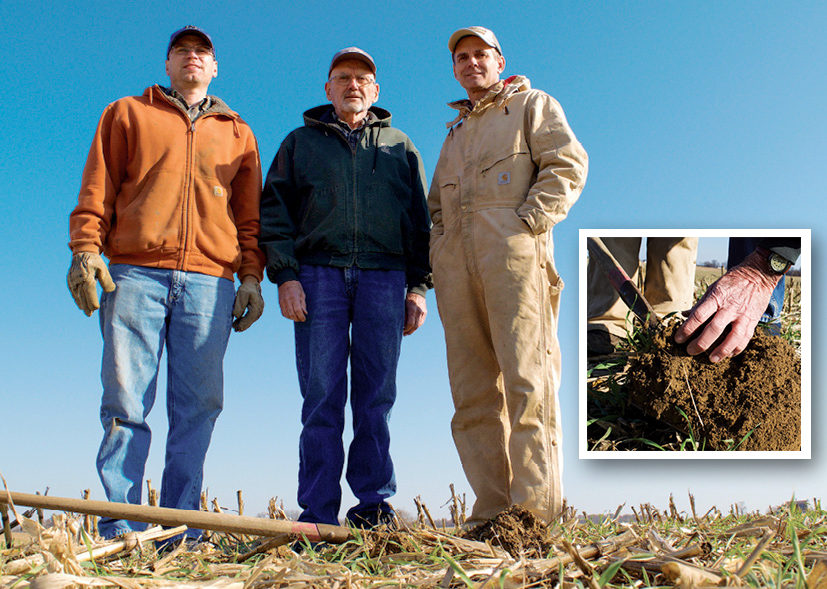When Nathan Wilson first considered no-tilling corn and soybeans he was worried it might not work well. He had seen some poor stands and weed control problems on other farms and field days. But it turned out Nathan just needed to set foot on the right farm to see the possibilities.
He attended a no-till field day on Neil Springer’s Farm in Knox County, Ohio, during the 1970s and observed what he termed “immaculate soybeans and corn” and waterways that went right up to the crops, which minimized erosion.
“I just remember looking at that and saying, ‘Wow, no-till doesn’t have to be a failure,” recalls Nathan, who was serving on the local soil conservation board at the time. When Springer started no-tilling in 1974, he was told by ‘coffee shop experts’ he’d have crop residue 2 or 3 feet deep if he didn’t plow the residue under.
Stepping Up
The picture is a little different now as Nathan and his sons Ryan and Wyatt, have been no-tilling corn and soybeans for 30 years, managing a total of 3,800 acres as of last fall.
The first person to no-till in the family was Nathan’s uncle, Frank, who liked efficient allocations of time, equipment and expenses. He started no-tilling with an Allis Chalmers planter, driving only 3 mph to keep the fluted coulters from throwing dirt from the seed row. Achieving proper seed depth was tricky due to the gauge wheels being in the rear of the planter instead of near the disc opener with later John Deere MaxEmerge planters.
During the early 1980s Nathan tried no-tilling on a limited basis, once flying on cereal rye in standing corn in September. Next spring he planted beans in green rye in late May, followed by a floater spraying Gramoxone. “A lucky 4-inch rain occurred that night, and everything grew just fine. But 8-foot rye made my heart skip a beat,” Nathan recalls. Cover crops were not tried again for 25 years.

The Wilson family gets cover crops out in a hurry after harvest with this Flexi-Coil 787 air cart mated to a 30-foot Kuhn Krause Excelerator 8000 vertical-tillage tool. They can cover 250 acres a day seeding cereal rye at 9-10 mph. The machine seeding tube and deflector spacings are set to 25 inches and coulters, spider wheels and rolling baskets help process residue and incorporate the seed.
No-till was gradually increased from 1977 until the family was 100% no-till in 1988. The Wilsons started no-tilling corn first in 30-inch rows and no-tilled soybeans in 15-inch rows with a Deere planter, double-cropping them into a highly managed wheat crop.
There was a 10-year period where they strip-tilled, building strips in the fall for corn after wheat, and sometimes after soybeans. But heavy rains pounding the area made a mess of stripped fields.
“There were some years where it rained so much the creek would get out of its banks and wash the whole strip right down the creek. Just as deep as we stripped it, the dirt was completely gone,” Nathan says. “We’d just have these ridges out there that we hadn’t tilled.”
Even though wheat was helping Wilsons reduce erosion, they quit seeding it due to low prices and the labor cost of making 7-10 passes from planting to harvest.
Coming Back to Covers
Eventually the Wilsons started looking at cover crops again as a way to improve their soils. Having read about the benefits of annual ryegrass in a magazine, Ryan went to Indiana to visit NRCS educator Barry Fisher, who took him to fields with examples of corn no-tilled into killed annual ryegrass.
“Just observing the root mass, I thought, ‘Oh my gosh. This has got to help us somehow,’” Ryan recalls thinking. “I was really impressed with the soil tilth.”
They tried aerial seeding annual ryegrass and obtained good stands, but had difficulties killing it at the proper time.
You May Also Be Interested In...
4 Strategies For Effective No-Tilling
Enhance your no-till system with practical strategies from leading no-till experts! In this guide, four no-till innovators who have invested numerous resources and energy, share their answers to these questions. They’re eager to share their experiences to help you avoid the hard lessons they’ve learned studying and developing no-till systems. You’ll get clear, actionable strategies you can implement right now in your no-till operation. Download now »
But something seemed to click after Wyatt and Ryan attended the 2012 summer field day at Carroll, Ohio, no-tiller David Brandt’s farm. It was the same year a major drought hit the Corn Belt and much of the U.S.
Brandt used a probe to show the temperature difference of at least 30 F from his cover-cropped, no-tilled soil vs. his neighbor’s soil — a measurement that can have a major effect on soil biological activity and plant stress.
Ryan and Wyatt recalled that their soil back home was dry and as hard as a brick, but Brandt’s soil was soft, damp and mellow.
“To put the icing on the cake, when we drove the van out of Brant’s field where we had parked, we noticed it was hard to get moving because the tires had sunk into the ground because his soil was so mellow. That couldn’t have happened on our farm when it was that dry.
“It inspired us, and we said, ‘This is what we need to do,’” Ryan recalls.

Wet weather during the spring sometimes posed a problem for the Wilsons when they wanted to terminate cereal rye ahead of no-tilled corn. They bought this 60-foot-wide Top Air ATV sprayer and pull it with a John Deere Gator to get through wet spots and terminate rye in a timely manner without damaging their fields or getting stuck.
The Wilsons bought a 36-foot Deere 1790 drill in 2013 and started seeding cereal rye that fall right behind the combine at a rate of 20-30 pounds an acre after both corn and soybeans. While this approach worked, they felt the need for speed and less maintenance.
So in 2017, they bought a Flexi-Coil 787 air cart and used hoses and brackets to mate it to a 30-foot Kuhn Krause Excelerator 8000 vertical-tillage tool to seed covers while traveling 9-10 mph. The machine seeding tube and deflector spacings are set to 25-inches and three towers are used to distribute seed. Coulters, spider wheels and rolling baskets help process residue and incorporate the seed.
“We can seed 250 acres a day with that machine,” Ryan says. “The Excelerator does more to the corn stalks, beating up the root balls ahead of the soybean planter.”
What Allelopathy?
The Wilsons no-till corn in 30-inch rows with a 24-row Deere 1770NT Max Emerge XP planter outfitted with Martin-Till floating row cleaners, cast iron closing wheels, Precision Planting’s AirForce down pressure system and Keeton seed firmers.
At planting, they typically apply 30 pounds of nitrogen (N) 2 inches from the furrow to compensate for N they feel is being lost from the cereal rye, potentially punishing young corn seedlings. Through soil tests, they’ve been tracking a significant drop in sulfur levels for the last 10 years, so they’ve been applying sulfur ahead of corn. They also apply up to 10 pounds an acre of zinc with the planter or broadcast before planting.
Even though many no-tillers avoid planting corn into cereal rye in spring due to allelopathy issues, the Wilsons have come up with a two-part plan to manage that challenge.
For acres going to corn, they aim to terminate cereal rye about 2 weeks before planting. If they can plant corn early enough, they terminate the rye with glyphosate while the plants are smaller and easier to control.
How cereal rye is terminated with soybeans depends on the height of the rye. If rye is short the Wilsons terminate with glyphosate after planting beans. If planting is later and cereal rye is nearing waist high, they will no-till soybeans into the tall plants and use an I&J roller-crimper to roll the rye down, spraying it later with glyphosate when the plants are in the three- and four-trifoliate stage.
At times cereal rye has been in the pollination stage when they were no-tilling soybeans, which covered everything with a sticky yellow mess.
One advantage with the roller comes at soybean harvest because straw from cereal rye is knocked down and not taken through the machine with the grain. “And it helped the soybeans grow a stronger stem, instead of tall and spindly and likely to lodge,” Ryan says.
Another Tool
Timing is key with termination of cover crops. There were times when the Wilsons were unable to work around spring rainstorms dumping several inches of water on their fields in one event.
So they bought a 60-foot-wide Top Air ATV sprayer that is pulled by a Deere Gator to help them get into fields.
The tires only register about 11 psi to the soil and barely leave cleat marks in the field,” Ryan says. The rig has Ag Leader GPS guidance to help avoid overlaps, and they can cover a 60-foot swath traveling up to 10 mph as they apply herbicides to terminate rye.
“It can make it through 98% of the wet spots without getting stuck,” Ryan says. “You just have to get the cereal rye killed if you’re going to do it ahead of corn.”








Post a comment
Report Abusive Comment